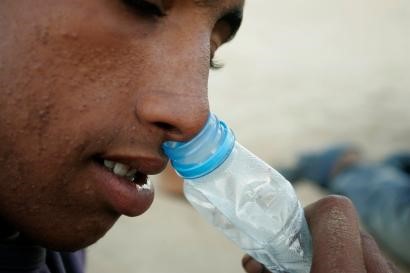Africa’s desperate youth are getting high on opioids and anything they can get their hands on

Sniffing around for a cheap high.
The actual details of the
death of a young man called “Kenneth aka Dagba Junior” from the Lagos suburb of
Ketu remain murky, but local news reports are clear on the culprit: gutter
water.
His friends say Kenneth had gone out for the night at a local hotel and decided to indulge in the potent mix of codeine, tramadol, rohypnol, cannabis and water or juice. While the mixture enhances the enjoyable high of each drug ingredient, their side effects are also increased leading to a very risky outcome. Reports say after taking his gutter water mix he had a seizure, and was rushed to a local hospital, where he was declared dead a few hours later.
Gutter water isn’t the only
dangerous cocktail of drugs which a generation of young Africans use to get
their high or fix for relatively cheap. Everything from lizard dung and cobwebs
to petrol fumes and rat poison are on the list of DIY drugs for a generation of
poor, disenfranchised young urban Africans who feel there are few options for a
better life.
With expensive illicit drugs
like cocaine and heroin out of reach for many unemployed young people, they’re
turning to a range of cheap options—and concoctions—to get high. The spreading
addiction among Africa youth to cheap synthetic opioids brought in from China
and India has had much press recently.
Tramadol, a pain relief drug,
is flooding African cities including Khartoum, Libreville, Cairo and
Accra. Last week, Nigeria banned
codeine, typically found in cough syrups, following a BBC documentary which
showed that a thriving black market trade involving insiders at some of the
country’s biggest pharmaceutical companies.
Opioids are generally cheap
and widely available due to unregulated production: Tramadol pills cost less
than a dollar and codeine syrups sell for $3 in Nigeria. As a result, young
adults are increasingly reaching extreme measures in search of a cheap high.
Combining opioids with
alcohol is a popular choice. The mixture of two central nervous system
depressants results in a wider effect on the brain: codeine binds to opioid
receptors while alcohol affects the brain’s gamma-aminobutyric acid receptors.
Both drugs interact with neurotransmitters tied to mood, particularly dopamine
and serotonin, and result in the high.
More than availability and
the creativity of youthful addicts, much of the drug abuse culture is fueled by
the inability of most African economies to grow quickly and get big enough to
cater to a bulging youth population. High unemployment rates mean that millions
of young people in large countries like Nigeria and South Africa to much
smaller ones have few options and are susceptible to turning to drugs as an
escape. It’s a problem that will likely get worse with an extra 1.3 billion
people set to added to the continent’s population by 2050.
Beyond opioids
Beyond opioids and alcohol, young adults are turning to several crude options for a high. Smoking lizard parts and dung, known to possess psychoactive qualities is rampant in northern Nigeria. Sniffing glue, petrol, sewage and urine as inhalants has also become common. Hydrocarbons in petrol suppress the central nervous system to deliver effects similar to getting drunk while gas from the fermented sewage has attributes of a hallucinogenic and delivers a “euphoric high similar to ingesting cocaine.”
Homeless people in Somalia sniffing
glue.
REUTERS/OMAR FARUK
Homeless people in Somalia
sniffing glue.
In South Africa, a successful public health response to HIV/AIDS has led to a drug craze fueled by state-administered anti-retroviral treatment. “Nyaope” is a cocktail of anti-retroviral drugs, low-grade heroin, marijuana and sometimes rat poison. Also known as whoonga or sugars, the cheap drug is rife in some of South Africa’s most impoverished neighborhoods. “Tik,” as crystal methamphetamine is known in South Africa, has become popular delivering a high that can last for up to eight hours. Its effects, though, can last a lifetime as the stimulant is associated with brain and heart damage.
In neighboring Namibia and
Botswana, drug abuse is also growing rapidly especially among young and
unemployed. In Kenya, as as far back as 2009, a study showed that thousands of
homeless street children were already addicted to sniffing glue.
The drug combinations may
differ from country to country, but the symptoms are the same: a lack of
opportunities for the so-called youth bulge. African governments are struggling
to find a cure to both the the cause and the epidemic. Few have adequately
staffed and equipped public rehabilitation centers or a coordinated public
health response, never mind how to create jobs for Africa’s youth.
Source: qz.com/africa
Writers:Yomi Kazeem &
Lynsey Chutel
Mindstudio Community: Engage
the Mindstudio Community by sharing your thoughts in the comment box below
about this article. We would love to hear from you!

Comments
Add New Comment